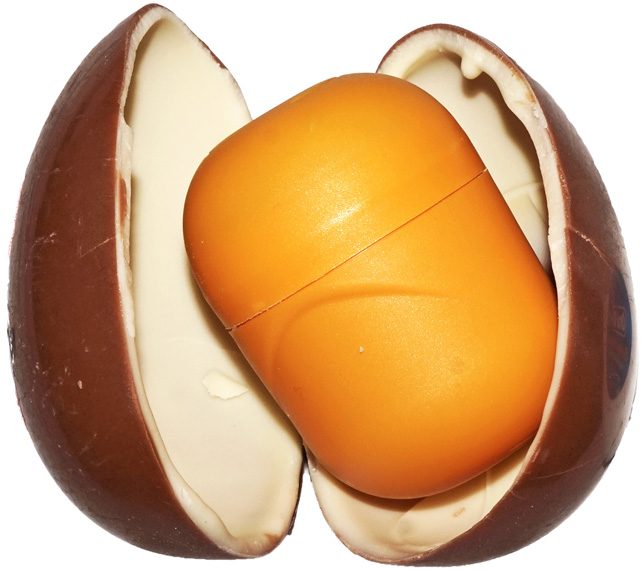Ever wish things hadn’t changed for the worse? Ben Redford of Mayku gets all nostalgic for the sense of adventure and challenge that Kinder Surprise eggs once inspired in him
Have you bought a Kinder Surprise recently? If not – don’t bother. Not unless you want a slightly sad surprise, that is.
What was once a beautifully detailed set of tiny parts, ready to be meticulously constructed to create a miniature feat of product design and micro branding, has now been reduced, more often than not, to a single plastic form. There’s no need for self-assembly, nor any sense of challenge.
If you’re lucky, you might get a little sheet of stickers to plaster onto the little plastic blob. And if you’re really lucky, you might even get two plastic pieces to mash together.
Call me nostalgic, but I used to love biting open the plastic barrel of a Kinder Surprise, just to get to the mysterious kit inside and begin construction work.
Advanced students of the egg, of course, undertook the task without reference to the instructions. In fact, I would often toss the chocolate egg away, to the horror of my chubby sibling.

Co-created by by Michele Ferrero and William Salice in 1968, the Kinder Surprise has shifted over 30 billion units since 1974. It’s illegal to import them into the continental USA, due to perceived safety hazards, and doing so can incur a fine of up to $2,500.
Image Tiia Monto
Why do I care so much about Kinder Surprise? Because it set me on a road to making products and understanding the world of branding at an early age.
Their instructions were complete assembly procedures. The tiny poster accompanying a toy was part of a compact branding exercise.
This was my first foray into seeing how things were actually made, not to mention how they could be shipped within the constraints of a chocolate shell. Kinder egg components of the early nineties even came with the plastic frames and sprue – tell-tale signs of an injection-moulded part. That meant you had to pop components out carefully in order to build your mini masterpiece.
I would inspect in great detail every ejector pin impression, every sink mark and every tiny reference number, hoping to glean some extra information on how these wonders were made.
So I can’t begin to describe the disappointment of opening a Kinder egg today, to find a ‘onesie’ – a single plastic shape. No further action required.
Moving on
As a child, after mastering ‘the way of the egg’, I graduated to more advanced kits – first Airfix, then RC cars, followed by full-on disassembly of any electronic device I could get my hands on, much to the chagrin of my mother.
The thing is, I think the story of Kinder Surprise is symptomatic of what’s happening with the greater landscape of our material culture. All of our objects are becoming lozenge-like blobs of plastic and brushed aluminium.
Hermetically sealed at a factory, then shipped across the sea, they pass through our hands like a slippery block of machined nothing.
We have no idea how they are put together, how they come apart or how they leave this world.
They pass through our hands passively, without giving us a deeper understanding of their subtle intricacies. In other words, much like the disappointing blog in a Kinder egg, these objects have no hidden secrets to offer up to the curious mind that explores them.
I still see reason for hope, though. Kano has made a beautiful computer that you build yourself. Ultimaker goes from strength to strength. Glowforge has made one awesome domestic laser cutter.
Hopefully, the product world can draw inspiration from their culinary counterparts (delicious food assemblies are products, too, in the restaurant world) to see how the availability of small-scale, advanced culinary equipment has led to an explosion of imagination and innovation in professional and domestic kitchens the world over.
Take a look, for example, at the sub-$200 sous vide machines, nitrogen canisters, atomisers and other awesome gadgetry now available.
This is why myself and Alex Smilansky started Mayku. We’re building the world’s first desktop factory to put the power of making in people’s hands. The first machine in our desktop production line is a super-simple desktop vacuum former, the FormBox. It’s been incredible to see what people have been making as Formbox has started arriving on people’s doorsteps around the world.
I’d love to see the same amount of passion, attention and dedication (not to mention Instagram activity) that we’ve witnessed in the food world in the past few years go into pushing products forward.
Imagine homespun, factory-grade products made at home. Hopefully, by building the right tools for the right people, we can make that happen.
And maybe, just maybe, people will be able to build their own Kinder Surprise toys – and make them awesome again.
Ben Redford is CPO and Co-Founder at Mayku.
Watch his presentation and the launch of the FormBox at DEVELOP3D LIVE online here or learn more about what he’s up to at mayku.me

Ben Redford of Mayku gets nostalgic for the adventure and challenge of Kinder eggs
Default






